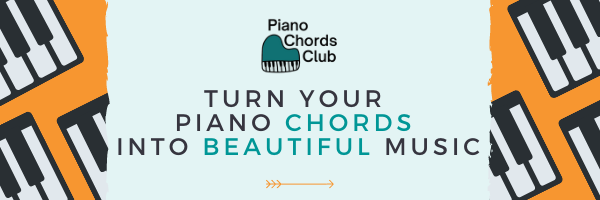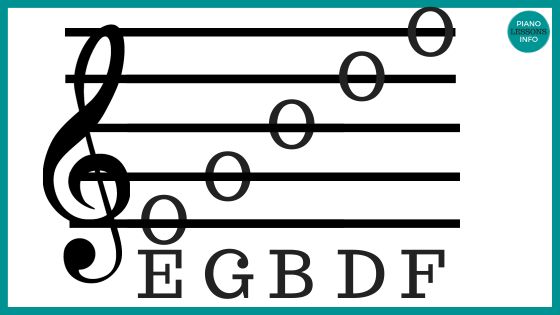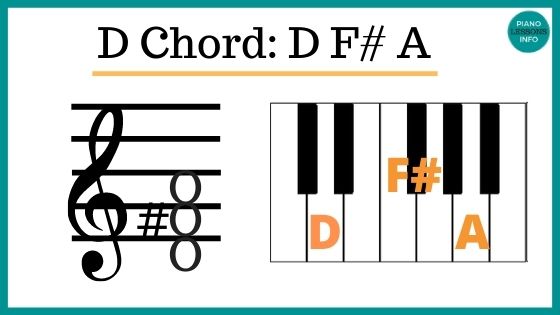Am Piano Chord Notes, How To & Diagrams (A Minor Chord)
Am piano chord is often one of the first 4 chords I teach to anyone. It's a great basic chord and made up of the notes A C E.
When you start learning, it's great to play the chord in that order - A C E - but it doesn't have to be. Try to keep A as the lowest note in your left hand but the rest of the notes can be sprinkled anywhere above that.
On this page you're going to learn:
- the Am piano chord notes
- Am piano chord chart
- How to play it (there's a video)
- which fingers to use to play Am piano chord
- Am/C piano chord
- Am/E piano chord
- Am chord inversions
- which key Am is in
- and a bit of chord theory
Let's get started!
Am Piano Chord Notes
The notes of the Am chord are: A C E.
Am is a minor chord - the small m indicates that. The sound of minor chords is often thought of as a "sad" sound.
If you want to play the Am chord in your left hand, you can. People often start by playing the full chord in the left hand as a solid block.
Another way to play it is to play the A note in the left hand and the full chord in your right hand.
Am Piano Chords Chart
This is what the A minor chord looks like in music and on the piano keys.
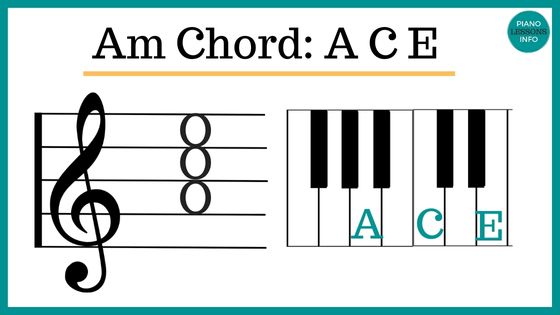 Am Piano Chord Chart
Am Piano Chord ChartHow To Play A Minor Chord on Piano
The video below shows you how to play the Am chord on the piano and which fingers to use. It'll also let you know what it sounds like.
Am Piano Chord Finger Positions
To play the A minor chord, use the standard fingers positions for all major and minor chords.
This means to use fingers 1, 3 and 5 or your thumb, middle finger and pinkie, to play the chord. If this doesn't feel comfortable, I'd encourage you to stick with it and get used to this position. It's going to come in handy later on.
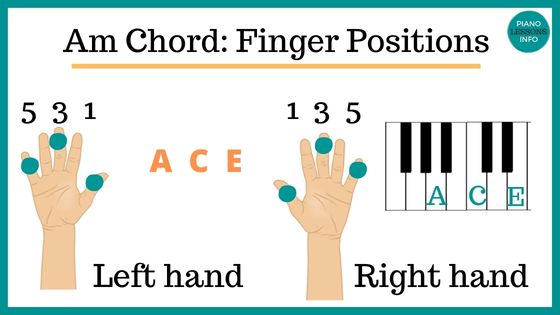
Am Piano Chord Progression
Here are some good, basic chord progressions to practice the Am chord with:
Am Chord Progression 1:
Am Dm C E
Am Chord Progression 2:
Am C G Em
Am Chord Progression 3:
C F Am G
What Does Am/C Mean?
The Am/C piano chord is a type of slash chord. Whatever comes after the slash - in this case it's C - is what you play in your left hand as your lowest note. C is your bass note.
This gives the chord a different sound. In this case, it's not going to sound so strongly minor with the extra emphasis on C.
So basically, play C in your left hand. Play the rest of the notes of the chord (A C E) above that.
Am/E Piano Chord
Am/E is another example of a slash chord. With this one, we're going to play E as the lowest note in our left hand and the rest of the notes of the chord above that.
The notes can be in any order but we want E as the lowest note here.
Inversions for A Minor Chord
Inversions are standard ways of playing a chord in different positions and very useful. They are really fantastic to play for both beginners and advanced players. It's part of your exercise - similar to scales.
(If you don't know much about inversions, you can find out more here.)
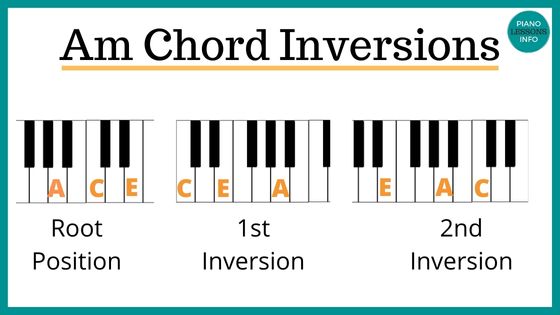
The inversions for the A minor piano chord are:
Root position: A C E
1st Inversion: C E A
2nd Inversion: E A C
Is the Key of Am and C The Same?
Yes! The key of A minor and C is the same - no sharps and no flats.
Every major key shares a key signature with a minor key and C major and A minor are partners. Both keys have no sharps and no flats in their key signature.
If you need more help understanding key signatures, visit the key signatures page.
Chord Theory for A Minor Chord
Now we know that the key of A minor has no sharps and no flats which means we can work out the chord, using the chord formula.
Minor chords are built on the 1st, 3rd and 5th notes of a minor scale.
The A minor scale is:
A B C D E F G A
So using the chord formula, we get A, C and E as the A minor chord.
If you need to look up more chords, visit the Piano Chord Charts page or download your own copy below.
Free Download:
Ultimate Chord Cheat Sheet

Subscribe below and get free access to the (printable) Ultimate Chord Cheat Sheet.
Recent Articles
-
Piano Notes Chart
Nov 20, 23 10:21 PM
Find a piano notes chart for treble clef and bass clef notes as well as the different types of notes. -
D Chord on Piano + Diagram, How To & Theory
Oct 24, 23 12:20 AM
Learn how to play the D chord on piano with diagram, fingering, D/A, D/F# and a theory explainer. -
Diminished Piano Chords: Chart & How to Make Them
Oct 09, 23 09:23 PM
Learn the different diminished piano chords and how to make them. Here you'll find both a diminished chord chart and an explanation.
- Home
- 14 Day Chord Challenge
- Am Piano Chord
Free Download:
Ultimate Chord Cheat Sheet

Subscribe below and get free access to the (printable) Ultimate Chord Cheat Sheet.



